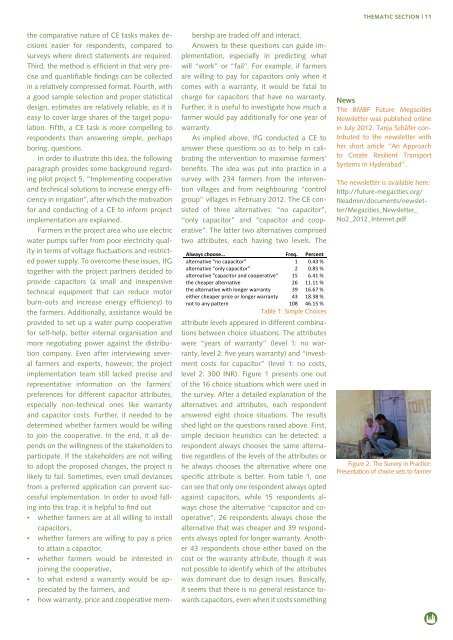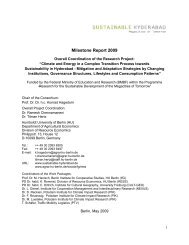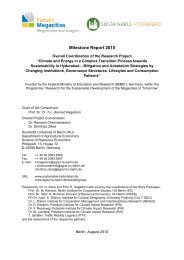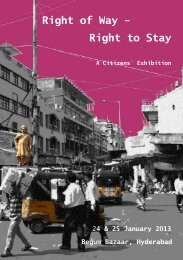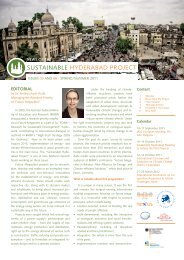SUSTAINABLE HYDERABAD PROJECT
SUSTAINABLE HYDERABAD PROJECT
SUSTAINABLE HYDERABAD PROJECT
You also want an ePaper? Increase the reach of your titles
YUMPU automatically turns print PDFs into web optimized ePapers that Google loves.
THEMATIC SECTION | 11<br />
the comparative nature of CE tasks makes decisions<br />
easier for respondents, compared to<br />
surveys where direct statements are required.<br />
Third, the method is efficient in that very precise<br />
and quantifiable findings can be collected<br />
in a relatively compressed format. Fourth, with<br />
a good sample selection and proper statistical<br />
design, estimates are relatively reliable, as it is<br />
easy to cover large shares of the target population.<br />
Fifth, a CE task is more compelling to<br />
respondents than answering simple, perhaps<br />
boring, questions.<br />
In order to illustrate this idea, the following<br />
paragraph provides some background regarding<br />
pilot project 5, “Implementing cooperative<br />
and technical solutions to increase energy efficiency<br />
in irrigation”, after which the motivation<br />
for and conducting of a CE to inform project<br />
implementation are explained.<br />
Farmers in the project area who use electric<br />
water pumps suffer from poor electricity quality<br />
in terms of voltage fluctuations and restricted<br />
power supply. To overcome these issues, IfG<br />
together with the project partners decided to<br />
provide capacitors (a small and inexpensive<br />
technical equipment that can reduce motor<br />
burn-outs and increase energy efficiency) to<br />
the farmers. Additionally, assistance would be<br />
provided to set up a water pump cooperative<br />
for self-help, better internal organisation and<br />
more negotiating power against the distribution<br />
company. Even after interviewing several<br />
farmers and experts, however, the project<br />
implementation team still lacked precise and<br />
representative information on the farmers’<br />
preferences for different capacitor attributes,<br />
especially non-technical ones like warranty<br />
and capacitor costs. Further, it needed to be<br />
determined whether farmers would be willing<br />
to join the cooperative. In the end, it all depends<br />
on the willingness of the stakeholders to<br />
participate. If the stakeholders are not willing<br />
to adopt the proposed changes, the project is<br />
likely to fail. Sometimes, even small deviances<br />
from a preferred application can prevent successful<br />
implementation. In order to avoid falling<br />
into this trap, it is helpful to find out<br />
• whether farmers are at all willing to install<br />
capacitors,<br />
• whether farmers are willing to pay a price<br />
to attain a capacitor,<br />
• whether farmers would be interested in<br />
joining the cooperative,<br />
• to what extend a warranty would be appreciated<br />
by the farmers, and<br />
• how warranty, price and cooperative membership<br />
are traded off and interact.<br />
Answers to these questions can guide implementation,<br />
especially in predicting what<br />
will “work” or “fail”. For example, if farmers<br />
are willing to pay for capacitors only when it<br />
comes with a warranty, it would be fatal to<br />
charge for capacitors that have no warranty.<br />
Further, it is useful to investigate how much a<br />
farmer would pay additionally for one year of<br />
warranty.<br />
As implied above, IfG conducted a CE to<br />
answer these questions so as to help in calibrating<br />
the intervention to maximise farmers’<br />
benefits. The idea was put into practice in a<br />
survey with 234 farmers from the intervention<br />
villages and from neighbouring “control<br />
group” villages in February 2012. The CE consisted<br />
of three alternatives: “no capacitor”,<br />
“only capacitor” and “capacitor and cooperative”.<br />
The latter two alternatives comprised<br />
two attributes, each having two levels. The<br />
Always choose… Freq. Percent <br />
alternative “no capacitor” 1 0.43 % <br />
alternative “only capacitor” 2 0.85 % <br />
alternative “capacitor and cooperative” 15 6.41 % <br />
the cheaper alternative 26 11.11 % <br />
the alternative with longer warranty 39 16.67 % <br />
either cheaper price or longer warranty 43 18.38 % <br />
not to any pattern 108 46.15 % <br />
Table 1: Simple choices <br />
Table 1: Simple Choices<br />
attribute levels appeared in different combinations<br />
between choice situations. The attributes<br />
were “years of warranty” (level 1: no warranty,<br />
level 2: five years warranty) and “investment<br />
costs for capacitor” (level 1: no costs,<br />
level 2: 300 INR). Figure 1 presents one out<br />
of the 16 choice situations which were used in<br />
the survey. After a detailed explanation of the<br />
alternatives and attributes, each respondent<br />
answered eight choice situations. The results<br />
shed light on the questions raised above. First,<br />
simple decision heuristics can be detected: a<br />
respondent always chooses the same alternative<br />
regardless of the levels of the attributes or<br />
he always chooses the alternative where one<br />
specific attribute is better. From table 1, one<br />
can see that only one respondent always opted<br />
against capacitors, while 15 respondents always<br />
chose the alternative “capacitor and cooperative”,<br />
26 respondents always chose the<br />
alternative that was cheaper and 39 respondents<br />
always opted for longer warranty. Another<br />
43 respondents chose either based on the<br />
cost or the warranty attribute, though it was<br />
not possible to identify which of the attributes<br />
was dominant due to design issues. Basically,<br />
it seems that there is no general resistance towards<br />
capacitors, even when it costs something<br />
News<br />
The BMBF Future Megacities<br />
Newsletter was published online<br />
in July 2012. Tanja Schäfer contributed<br />
to the newsletter with<br />
her short article “An Approach<br />
to Create Resilient Transport<br />
Systems in Hyderabad”.<br />
The newsletter is available here:<br />
http://future-megacities.org/<br />
fileadmin/documents/newsletter/Megacities_Newsletter_<br />
No2_2012_Internet.pdf<br />
Figure 2: The Survey in Practice:<br />
Presentation of choice sets to farmer


